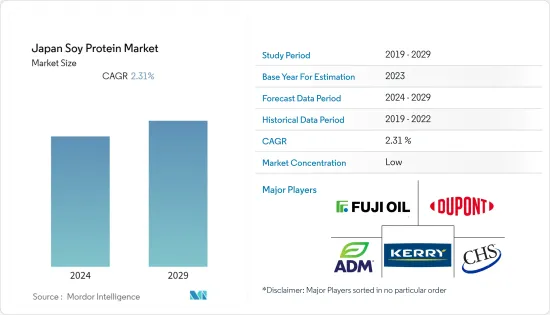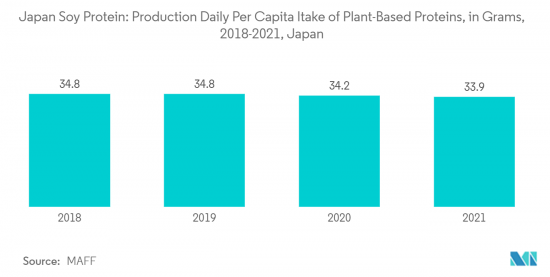
|
市場調査レポート
商品コード
1406972
日本の大豆タンパク質:市場シェア分析、産業動向・統計、成長予測、2024年~2029年Japan Soy Protein - Market Share Analysis, Industry Trends & Statistics, Growth Forecasts 2024 - 2029 |
||||||
カスタマイズ可能
適宜更新あり
|
|||||||
| 日本の大豆タンパク質:市場シェア分析、産業動向・統計、成長予測、2024年~2029年 |
|
出版日: 2024年01月04日
発行: Mordor Intelligence
ページ情報: 英文 100 Pages
納期: 2~3営業日
|
- 全表示
- 概要
- 目次
日本の大豆タンパク質市場は、2024年の1億9,644万米ドルから、今後5年間のCAGR 2.31%で成長すると予測されます。

主なハイライト
- 日本では植物由来の食品や飲食品の需要が増加しているため、大豆タンパク質はさまざまな食品や飲食品に使用されています。大豆タンパク質は消化しやすく、動物肉よりも高い栄養素を含んでいます。このため、肉の代替品として大豆タンパク質の使用が増加しています。大豆は強力なマメ科植物であり、肉のような食感を提供するため、肉の代わりになりやすいです。
- タンパク質、カルシウム、ビタミンA、ビタミンD、ビタミンB群の含有量は牛乳に匹敵するため、大豆強化牛乳の需要も高いです。豆乳の需要は、乳糖不耐症の増加により国内で増加しています。2022年のJSMAデータによると、日本の豆乳出荷量は12万6,300リットルでした。さらに、栄養価や機能性の高さから、スポーツ栄養や幼児食における大豆タンパク質の需要も増加しています。
- 米国農務省の2022年のデータによると、日本の大豆生産量は23万8,000トンでした。生産量の増加に伴い、大豆の加工も増加しています。市場の企業は、幅広い用途のために新しい大豆タンパク質を発売し、革新しています。例えば、ハリウッド化粧品ジャパンは、美容と健康のための大豆タンパク質を提供しています。大豆タンパク質は、肌の水分を長時間保持し、ツヤのある健康的な肌をもたらすことから、化粧品やパーソナルケア製品に使用されています。三菱化学の2021年のデータによると、日本のパーソナルケア製品への毎月の世帯支出は26.96米ドルでした。このため、パーソナルケア製品における大豆タンパク質の需要は伸びています。大豆タンパク質の使用は国内で増加しているが、麻タンパク質、エンドウ豆タンパク質、ジャガイモタンパク質などのような他の植物性タンパク質の存在が市場の成長を制限すると予想されます。
日本の大豆タンパク質市場動向
植物性タンパク質製品に対する需要の増加
- ビーガンや植物性食品の消費傾向の高まりにより、植物性食品や飲食品に対する消費者の需要が増加しています。そのため、大豆タンパク質の需要が増加しています。大豆タンパク質は、様々な乳製品や肉代替製品の代替品として使用されています。健康志向の高まりにより、消費者は低カロリーで栄養価の高い機能的な食品を選ぶようになっています。また、乳糖不耐症の増加により、植物性ミルクへの需要が増加しており、これが乳製品メーカーにおける大豆タンパク質の需要を高めています。
- 2022年のProcon.Orgのデータによると、日本では73%の人が乳糖不耐症です。そのため、植物性プロテインの需要が増加しています。中期的には、植物性食品と飲食品の需要の増加により、大豆タンパク質の需要は増加すると予想されます。

スポーツ栄養における用途の増加
- 国内の健康志向の消費者は、植物性タンパク質がより多くのエネルギーを供給し、体を長時間フレッシュに保つことから、植物性タンパク質の摂取を選択しています。市場企業は、パウダーや飲料のようなスポーツ栄養製品に大豆タンパク質のような植物性タンパク質を使用しています。植物性タンパク質は、筋肉疲労を軽減し、長時間体を活気づける。さらに、大豆タンパク質は筋肉増強に役立ちます。肥満や糖尿病などの疾病が増加しているため、消費者は健康を維持するためにスポーツに参加しています。
- スポーツ選手やスポーツ愛好家は、新鮮で健康な体を長く維持するために、植物性タンパク質を食事療法に取り入れています。2021年の総務省のデータによると、日本では7,479万人がスポーツを実践しています。このため、スポーツ栄養製品における大豆タンパク質の需要が増加しています。市場企業は、アスリートの体重管理、筋肉増強、総合免疫のために、分離物、濃縮物などの大豆タンパク質製品を提供しています。例えば、Meji HoldingsのSAVASブランドは、体重管理用の大豆タンパク質を提供しています。
日本の大豆タンパク質産業概要
日本の大豆タンパク質市場は細分化されており、トップ企業が主要市場をカバーしています。この市場の主要企業は、アーチャー・ダニエルズ・ミッドランド社、CHS社、デュポン社、不二製油グループ、大塚製薬株式会社です。植物性タンパク質の需要は国内で増加しており、そのため市場企業は新製品を開発しています。各社はまた、拡大する需要に対応するため、事業拡大、買収、提携、技術革新などの戦略に注力しています。
その他の特典:
- エクセル形式の市場予測(ME)シート
- 3ヶ月間のアナリストサポート
目次
第1章 イントロダクション
- 調査の前提条件と市場定義
- 調査範囲
第2章 調査手法
第3章 エグゼクティブサマリー
第4章 市場力学
- 市場促進要因
- タンパク質リッチ食品への需要増加
- 植物由来およびオーガニック原料の需要増加
- 市場抑制要因
- 代替タンパク質の存在
- ポーターのファイブフォース分析
- 新規参入業者の脅威
- 買い手/消費者の交渉力
- 供給企業の交渉力
- 代替品の脅威
- 競争企業間の敵対関係の強さ
第5章 市場セグメンテーション
- 形態
- 濃縮物
- 加水分解物
- 分離物
- エンドユーザー
- 飼料
- パーソナルケアと化粧品
- 食品・飲料
- ベーカリー
- 飲料
- 朝食用シリアル
- 調味料/ソース
- 乳製品および乳製品代替製品
- RTE/RTC食品
- スナック
- サプリメント
- ベビーフードおよび乳児用調製粉乳
- 高齢者栄養と医療栄養
- スポーツ/パフォーマンス栄養
第6章 競合情勢
- 最も採用されている戦略
- 市場シェア分析
- 企業プロファイル
- Royal DSM
- Kerry Group PLC
- Fuji Oil Group
- CHS inc
- DuPont de Nemours Inc
- Bunge Limited
- Archer Daniels Midland Company
- A. Costantino & C. SpA
- Mitsubishi Chemical Corporation
- Cargill Inc
第7章 市場機会と今後の動向

The Japan soy protein market is expected to grow from USD 196.44 million in 2024 at a CAGR of 2.31% over the next five years.
Key Highlights
- Soy protein is used in different foods and beverages as the demand for plant-based food and beverage products is increasing in the country. Soy proteins are easily digestible and provide higher nutrients than animal meat. Owing to this, the use of soy protein in meat substitutes is increasing. Soybeans are a powerful legume that can easily replace meat as it provides a meat-like texture.
- Soy-fortified milk also observed high demand because of comparable protein, calcium, vitamins A and D, and B vitamins content to cow's milk. The demand for soy milk is increasing in the country due to rising lactose intolerance. According to JSMA data from 2022, the shipment volume of soy milk in Japan was 126.3 thousand liters. Furthermore, the demand for soy protein in sports nutrition and infant food is also increasing due to its nutritional and functional properties.
- According to the United States Department of Agriculture data from 2022, the production of soybeans in Japan was 238 thousand tons. Owing to the increasing production, the processing of soya is also increasing in the country. The market players are launching and innovating new soy proteins for a wide range of applications. For instance, Hollywood Cosmetics Japan provides a range of soy proteins for beauty and health. Soy protein is used in cosmetics and personal care products as it holds moisture in the skin for a longer time and provides glowing, healthy skin. According to Mitsubishi Chemical Corporation data from 2021, monthly household expenditure on personal care products in Japan was USD 26.96. Owing to this, the demand for soy protein in personal care products is growing. Although the use of soy protein is increasing in the country, the presence of other plant-based proteins like hemp protein, pea protein, potato protein, and others is expected to restrict the growth of the market.
Japan Soy Protein Market Trends
Increasing Demand for Plant Based Protein Products
- Consumer demand for plant-based food and beverages is increasing due to the rising trend of vegan and plant-based food consumption. Therefore, the demand for soy protein is increasing. Soy protein is used as an alternative in different dairy as well as meat alternative products. Due to rising health consciousness, consumers are opting for the consumption of less calorific and more nutritious and functional food. Also, due to the increasing prevalence of lactose intolerance, the demand for plant-based milk is increasing, which is increasing the demand for soy proteins in dairy manufacturers.
- According to Procon.Org data from 2022, 73% of people in Japan are lactose intolerant. Old consumers in the country are looking for products that are easy to digest; hence, the demand for plant-based proteins is increasing. Over the medium term, the demand for soy protein is expected to increase owing to the increasing demand for plant-based food and beverage products.

Increasing Application in Sports Nutrition
- Health-conscious consumers in the country are opting for the consumption of plant proteins as they provide more energy and keep the body fresh for a longer time. The market Players are using plant proteins like soy proteins in sports nutrition products like powders and beverages. Plant proteins reduce muscle fatigue and keep the body energized for a longer time. Additionally, soy protein helps in muscle building. Due to rising diseases like obesity and diabetes, consumers are participating in sports to keep themselves healthy.
- Sports athletes and sports enthusiasts are incorporating plant proteins in their diet regime to be fresh and fit for a longer time. According to Ministry of Internal Affairs and Communications (Japan) data from 2021, 74.79 million people in Japan are practicing sports. Owing to this, the demand for soy protein in sports nutrition products is increasing. The market players are providing soy protein products like isolates, concentrates, and others for athletes' weight management, muscle building, and overall immunity. For instance, the SAVAS brand from Meji Holdings provides soy protein for weight management.
Japan Soy Protein Industry Overview
The Japan soy protein market is fragmented, with the top companies covering major markets. The major players in this market are Archer Daniels Midland Company, CHS Inc., DuPont de Nemours Inc., Fuji Oil Group, and Otsuka Pharmaceutical Co. The demand for plant proteins is increasing in the country, due to which the market players are innovating new products. The companies are also focused on strategies like expansions, acquisitions, partnerships, and innovations to cater to growing demand.
Additional Benefits:
- The market estimate (ME) sheet in Excel format
- 3 months of analyst support
TABLE OF CONTENTS
1 INTRODUCTION
- 1.1 Study Assumptions and Market Definition
- 1.2 Scope of the Study
2 RESEARCH METHODOLOGY
3 EXECUTIVE SUMMARY
4 MARKET DYNAMICS
- 4.1 Market Drivers
- 4.1.1 Increasing Demand for Protein-Rich Food
- 4.1.2 Increasing Demand for Plant-Based and Organic Ingredients
- 4.2 Market Restraints
- 4.2.1 Presence of Alternative Proteins
- 4.3 Porter's Five Forces Analysis
- 4.3.1 Threat of New Entrants
- 4.3.2 Bargaining Power of Buyers/Consumers
- 4.3.3 Bargaining Power of Suppliers
- 4.3.4 Threat of Substitute Products
- 4.3.5 Intensity of Competitive Rivalry
5 MARKET SEGMENTATION
- 5.1 Form
- 5.1.1 Concentrates
- 5.1.2 Hydrolyzed
- 5.1.3 Isolates
- 5.2 End-User
- 5.2.1 Animal Feed
- 5.2.2 Personal Care and Cosmetics
- 5.2.3 Food and Beverages
- 5.2.3.1 Bakery
- 5.2.3.2 Beverages
- 5.2.3.3 Breakfast Cereals
- 5.2.3.4 Condiments/Sauces
- 5.2.3.5 Dairy and Dairy Alternative Products
- 5.2.3.6 RTE/RTC Food Products
- 5.2.3.7 Snacks
- 5.2.4 Supplements
- 5.2.4.1 Baby Food and Infant Formula
- 5.2.4.2 Elderly Nutrition and Medical Nutrition
- 5.2.4.3 Sport/Performance Nutrition
6 COMPETITIVE LANDSCAPE
- 6.1 Most Adopted Strategies
- 6.2 Market Share Analysis
- 6.3 Company Profiles
- 6.3.1 Royal DSM
- 6.3.2 Kerry Group PLC
- 6.3.3 Fuji Oil Group
- 6.3.4 CHS inc
- 6.3.5 DuPont de Nemours Inc
- 6.3.6 Bunge Limited
- 6.3.7 Archer Daniels Midland Company
- 6.3.8 A. Costantino & C. SpA
- 6.3.9 Mitsubishi Chemical Corporation
- 6.3.10 Cargill Inc

